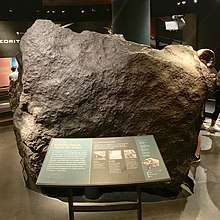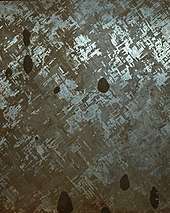Cape York meteorite
The Cape York meteorite, also known as the Innaanganeq meteorite, is one of the largest known iron meteorites, classified as a medium octahedrite in chemical group IIIAB. In addition to many small fragments, at least eight large fragments with a total mass of 58 tons have been recovered,[2] the largest weighing 31 tonnes (31 long tons; 34 short tons). The meteorite is named after the location where the largest fragment was found: near Cape York, in Savissivik, Meteorite Island, Greenland.
| Cape York | |
|---|---|
 The "Ahnighito" fragment in the American Museum of Natural History | |
| Type | Iron |
| Structural classification | Octahedrite, medium |
| Group | IIIAB |
| Composition | 7.58% Ni, 19.2 ppm Ga, 36.0 ppm Ge, 5.0 ppm Ir |
| Country | Greenland |
| Region | Avannaata |
| Coordinates | 76°08′N 64°56′W[1] |
| Fall date | A few thousand years ago[2] |
| Found date | Prehistoric[2] |
| TKW | 58200 kg[1] |
The date of the meteorite fall is debated, but was probably within the last few thousand years.[2] It was known to local Inuit for centuries, who used it as a source of meteoritic iron for tools. The first foreigner to reach the meteorite was Robert Peary in 1894, with the assistance of Inuit guides. Large pieces are on display at the American Museum of Natural History and the University of Copenhagen Geological Museum.
History
The meteorite fell to Earth after the retreat of glaciers from the area. All fragments recovered were found at the surface, partly buried, some on unstable terrain. The largest fragment was recovered in an area where the landscape consists of "flowing" gravel or clay-like sediments on permafrost, indicating that it had been in place for no more than a few thousand years.[2] Other estimates have put the date of the fall as 10,000 years ago.[3]
The iron masses were known to Inuit as Saviksoah (Great Iron, later renamed Ahnighito by Robert Edwin Peary)[4] weighing 31 metric tons (31 long tons; 34 short tons); the Woman, weighing 3 metric tons (3.0 long tons; 3.3 short tons); and the Dog, weighing 400 kilograms (880 lb).[5] For centuries, Inuit living near the meteorites used them as a source of metal for tools and harpoons.[6][7] The Inuit would work the metal using cold forging—that is, by hammering the metal with stones. Excavations of a Norse farm in 1976 located an arrowhead made of iron from the meteorite, dating from the 11th to 14th century AD; its presence is evidence of Norse journeys to northern Greenland.[2]

In 1818, the British First Ross Expedition (led by Captain John Ross) made contact with Inuit on the northern shore of Melville Bay, who stated they had settled in the area to exploit a nearby source of iron.[2] The Inuit described the location of this iron, but poor weather and sea ice prevented Ross from investigating further.[2] Ross correctly surmised that the large iron rocks described by the Inuit were meteorites, and purchased several tools with blades made of the meteoritic iron.[2]
Between 1818 and 1883, five further expeditions to the area were mounted by Britain, Sweden and Denmark, which all failed to find the source of the iron.[2] Only in 1894 did a Western explorer reach the meteorite: Robert E. Peary, of the US Navy.[2] Peary enlisted the help of a local Inuit guide, who brought him to Saviksoah Island, just off northern Greenland's Cape York. It took Peary three years to arrange and carry out the loading of the heavy iron meteorites onto ships. This process required the building of small, short railroad. Peary sold the pieces for in $40,000 (equivalent to $1.23 million in 2019[8]) to the American Museum of Natural History in New York City where they are still on display. It is unknown whether the fragments were purchased from the Inuit or stolen.
Today the 3.4 by 2.1 by 1.7 metres (11.2 ft × 6.9 ft × 5.6 ft) piece named Ahnighito is open for viewing at the American Museum of Natural History in the Arthur Ross Hall. It is the second-heaviest meteorite to have been relocated (after El Chaco, at 37 tons). It is so heavy that it was necessary to build its display stand so that the supports reached directly to the bedrock below the museum. [9]
In 1963, a fourth major piece of the Cape York meteorite was discovered by Vagn F. Buchwald on Agpalilik peninsula.[5] The Agpalilik meteorite, also known as the Man, weighs about 20 metric tons (20 long tons; 22 short tons), and it is currently on display in the Geological Museum of the University of Copenhagen, Denmark. Other smaller pieces have also been found, such as the 3 metric tons (3.0 long tons; 3.3 short tons) Savik I meteorite found in 1911 and the 250 kilograms (550 lb) Tunorput fragment found in 1984. Surveys of the area with a magnetometer in 2012 and georadar in 2014 found no evidence of further large iron fragments, either buried or on the surface.[2]
The Cape York asteroid has been suggested by the crater discoverers to be a part of the asteroid which created the Hiawatha crater, but which split off prior to impact.[10]
Specimens
Each of the most important fragments of Cape York has its own name (listed in order of discovery date):
- Ahnighito (the Tent), 30,900 kilograms (68,100 lb),[11] 1884–1897, Meteorite Island, 76°04'N – 64°58'W
- Woman, 3,000 kilograms (6,600 lb),[11] 1897, Saveruluk, 76°09'N – 64°56'W
- Dog, 400 kilograms (880 lb), 1897, Saveruluk, 76°09'N – 64°56'W
- Savik I, 3,400 kilograms (7,500 lb),[11] 1913, Savequarfik, 76°08'N – 64°36'W
- Thule, 48.6 kilograms (107 lb), summer 1955, Thule, 76°32'N – 67°33'W[12]
- Savik II, 7.8 kilograms (17 lb), 1961, Savequarfik, 76°08'N – 64°36'W
- Agpalilik (the Man), 20,000 kilograms (44,000 lb), 1963, Agpalilik, 76°09'N – 65°10'W[11]
- Tunorput, 250 kilograms (550 lb), 1984
 Slice of Agpalilik in the Geological Museum in Copenhagen
Slice of Agpalilik in the Geological Museum in Copenhagen Agpalilik outside the Geological Museum in Copenhagen
Agpalilik outside the Geological Museum in Copenhagen
Composition and classification

It is an iron meteorite (medium octahedrite) and belongs to the chemical group IIIAB.[1] There are abundant elongated troilite nodules. The troilite nodules contain inclusions of chromite, sulfides, phosphates, silica and copper. The rare nitride mineral carlsbergite (CrN) occurs within the matrix of the metal phase. Graphite was not observed and the nitrogen isotopes are in disequilibrium.[13]
See also
- Glossary of meteoritics
- History of ferrous metallurgy
- List of largest meteorites on Earth
- Archaeometallurgy
- Inuit culture
- Meteoric iron
References
- Cape York on the Meteoritical Bulletin Database
- Martin Appelt, Jens Fog Jensen, Mikkel Myrup, Henning Haack, Mikkel Sørensen, Michelle Taube (2014). The cultural history of the Innaanganeq/Cape York meteorite (PDF) (Report). The Greenland National Museum & Archives. Retrieved 7 November 2019.CS1 maint: uses authors parameter (link)
- Pringle, Heather (1997). "New Respect for Metal's Role in Ancient Arctic Cultures". Science. 277 (5327): 766–767. doi:10.1126/science.277.5327.766.
- Peary, Robert (1898). Northward Over the "Great Ice". F.A. Stokes Company. pp. 583–4.
- The Permanent Commission on Meteorites of the International Geological Congress (1963). "Discovery of Cape York (Apalilik) Iron Meteorite, Northwest Greenland" (PDF). Meteoritical Bulletin. 28.
- T. A. Rickard (1941). "The Use of Meteoric Iron". Journal of the Royal Anthropological Institute. 71 (1/2): 55–66. doi:10.2307/2844401. JSTOR 2844401.
- Buchwald, V F (1992). "On the Use of Iron by the Eskimos in Greenland". Materials Characterization. 29 (2): 139–176. doi:10.1016/1044-5803(92)90112-U.
- Federal Reserve Bank of Minneapolis. "Consumer Price Index (estimate) 1800–". Retrieved January 1, 2020.
- "Ahnighito". American Museum of Natural History. Retrieved 2016-06-30.
- "Greenland ice sheet hides huge 'impact crater'". BBC. Retrieved November 15, 2018.
- J. Kelly Beatty, Carolyn Collins Petersen, Andrew Chaikin. The new solar system. Cambridge University Press, 1999, ISBN 0-521-64587-5
- Meteoritical Bulletin Database: Thule
- Zipfel, J.; Kim, Y.; Marti, K. Nitrogen Isotopic Disequilibrium in the Cape York III A Iron
Bibliography
- Patricia A. M. Huntington. Robert E Peary and the Cape York meteorites
External links
| Wikimedia Commons has media related to Cape York (meteorite). |
